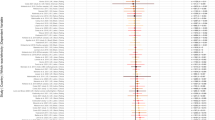Abstract
Rational incentives and psychological involvement are hypothetical alternative motives for voting participation. The relationship of these alternative motives to turnout is explored in the presidential elections held between 1952 and 1976. Rational incentives as such are not more productive of turnout than other stimuli to psychological involvement in the electoral situation.
Similar content being viewed by others
References
Bartos, Otomar J. (1967).Simple Models of Group Behavior. New York: Columbia University Press.
Brody, R. A., and B. I. Page (1973). “Indifference, Alienation, and Rational Decisions: The Effects of Candidate Evaluations on Turnout and the Vote.”Public Choice 15: 1–17.
Chase, Ivan D. (1974). “Models of Hierarchy Formation In Animal Societies.”Behavioral Science 19: 374–382.
Downs, A. (1957).An Economic Theory of Democracy. New York: Harper & Row.
Ferejohn, John, and Morris Fiorina (1974). “The Paradox of Not Voting: A Decision Theoretic Analysis.”American Political Science Review 68 (June): 525–536.
—— (1975). “Closeness Counts Only in Horseshoes and Dancing.”American Political Science Review 69 (September): 920–925.
Fishbein, M. and F. S. Coombs (1971). “Basis for Decision: An Attitudinal Approach toward an Understanding of Voting Behavior.” Paper presented at the 67th Annual Meeting of the American Sociological Association, September 7–11, 1971.
Grofman, Bernard, and A. J. Mackelprang (1974). “The Strange Case of Partisan Attitude and Vote Direction and Vote Turnout.” Paper presented at the Conference on Wahlforschung and Systemanalysis, Bad Mustereifel, West Germany, June 28–30.
Grofman, Bernard (1979). “Abstention in Two-Candidate and Three-Candidate Elections When Voters Use Mixed Strategies.”Public Choice 34, 2: 189–200.
Kelley, Stanley, and Thad W. Mirer (1974). “The Simple Act of Voting,”American Political Science Review 68: 572–591.
Landau, H. G. (1951a). “On Dominance Relations and the Structure of Animal Societies. I. Effects of Inherent Characteristics.”Bulletin of Mathematical Biophysics 13: 1–19.
Landau, H. G. (1951b). “On Dominance Relations and the Structure of Animal Societies. II. The Conditions for a Score Structure.”Bulletin of Mathematical Biophysics 13: 245–62.
—— (1953). “On Dominance Relations and the Structure of Animal Societies. III. The Conditions for a Score Structure.Bulletin of Mathematical Biophysics 14: 143–48.
McKelvey, Richard D., and Peter C. Ordeshook (1972). “A General Theory of the Calculus of Voting.”Mathematical Applications in Political Science 6:
Riker, William H., and Peter C. Ordeshook (1968). “A Theory of the Calculus of Voting.”American Political Science Review 62(March): 25–42.
—— (1974).An Introduction to Positive Political Theory. Englewood Cliffs, N.J.: Prentice-Hall.
Weisberg, Herbert, and Bernard Grofman (1981). “Candidate Evaluations and Turnout.”American Politics Quarterly (forthcoming).
Wolfinger, Raymond, and Steven Rosenstone (1977). “Who Votes.” Paper presented at the Annual Meeting of the American Political Science Association.
Author information
Authors and Affiliations
Rights and permissions
About this article
Cite this article
Brody, R.A., Grofman, B. Stimulus differentiation versus stimulus complexity as factors affecting turnout in two-candidate and multicandidate races. Polit Behav 4, 83–92 (1982). https://doi.org/10.1007/BF00987120
Issue Date:
DOI: https://doi.org/10.1007/BF00987120




